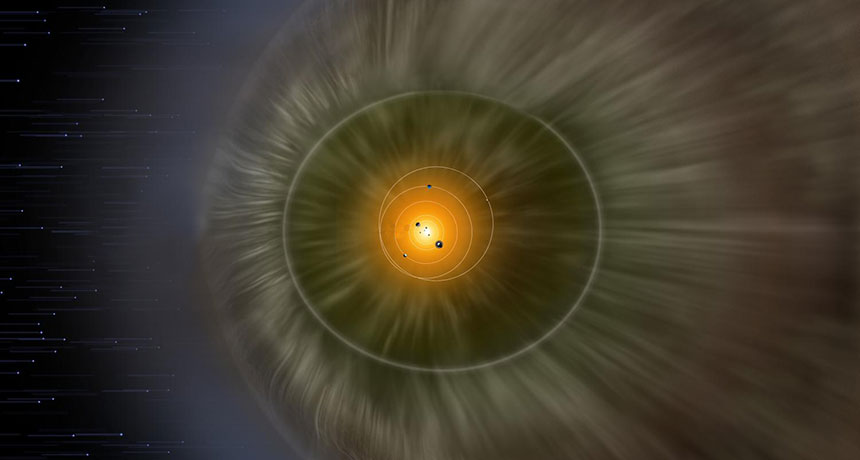NASA Spotted a Vast, Glowing 'Hydrogen Wall' at the Edge of Our Solar System

There's a "hydrogen wall" at the edge of our solar system, and NASA scientists think their New Horizons spacecraft can see it.
That hydrogen wall is the outer boundary of our home system, the place where our sun's bubble of solar wind ends and where a mass of interstellar matter too small to bust through that wind builds up, pressing inward. Our host star's powerful jets of matter and energy flow outward for a long stretch after leaving the sun — far beyond the orbit of Pluto. But at a certain point, they peter out, and their ability to push back the bits of dust and other matter — the thin, mysterious stuff floating within our galaxy's walls — wanes. A visible boundary forms. On one side are the last vestiges of solar wind. And on the other side, in the direction of the Sun's movement through the galaxy, there's a buildup of interstellar matter, including hydrogen.
And now NASA researchers are pretty sure that New Horizons, the probe that famously skimmed past Pluto in 2015, can see that boundary.
What New Horizons definitely sees, the researchers reported in a paper published Aug. 7 in the journal Geophysical Research Letters, is some extra ultraviolet light — the kind the researchers would expect such a wall of galactic hydrogen to produce. That replicates an ultraviolet signal the two Voyager spacecraft — NASA's farthest-traveling probes, which launched in the late 1970s — spotted all the way back in 1992. [Images: Dust Grains from Interstellar Space]
However, the researchers cautioned, that signal isn't a sure sign that New Horizons has seen the hydrogen wall, or that Voyager did. All three probes could have actually detected the ultraviolet light from some other source, emanating from much deeper in the galaxy, the researchers wrote.
But Alice, the instrument on board New Horizons responsible for this finding, is much more sensitive than anything the Voyagers had on board before beginning their own journey out of the solar system, the researchers wrote. And they said they expect Alice to function 15 to 20 more years.
New Horizons will continue to scan the sky for ultraviolet light twice a year, the researchers wrote, and report what it sees back to Earth.
Get the Space.com Newsletter
Breaking space news, the latest updates on rocket launches, skywatching events and more!
Editor's note: This story, written by a reporter for Space.com's sister site Live Science, included a quote mistakenly attributed to a press release by the researchers. The quoted phrase was in fact written by reporter Lisa Grossman of Science News in her coverage of this paper, and his been removed.
Originally published on Live Science.
Join our Space Forums to keep talking space on the latest missions, night sky and more! And if you have a news tip, correction or comment, let us know at: community@space.com.

Rafi wrote for Live Science from 2017 until 2021, when he became a technical writer for IBM Quantum. He has a bachelor's degree in journalism from Northwestern University’s Medill School of journalism. You can find his past science reporting at Inverse, Business Insider and Popular Science, and his past photojournalism on the Flash90 wire service and in the pages of The Courier Post of southern New Jersey.










